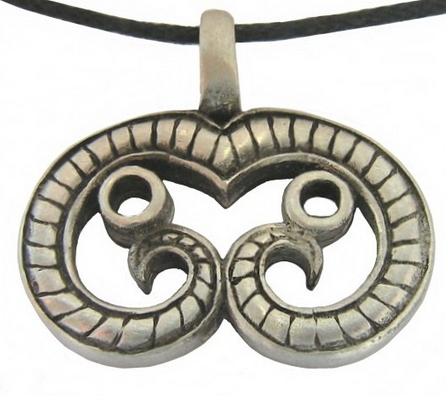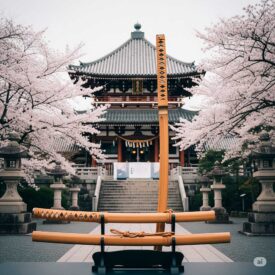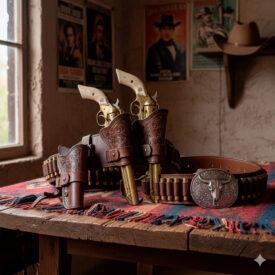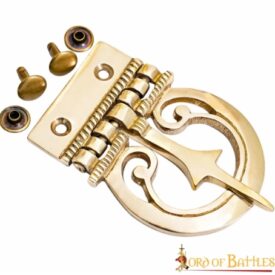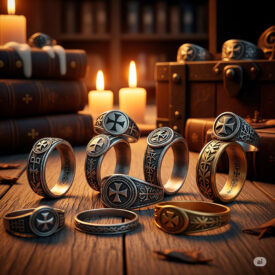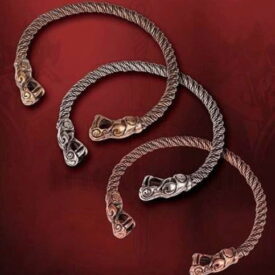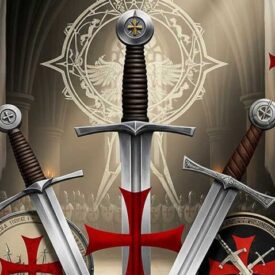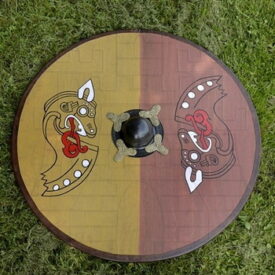Viking pendants are much more than simple ornaments; they are genuine portals to an era of explorers, warriors and a rich spiritual worldview. Each piece, with its intricate designs and deep meanings, offers a unique window into the complex Norse culture and the beliefs that guided the lives of the Vikings. Their fascination endures to this day, inspiring both historians and contemporary designers. These powerful amulets, charged with history and symbolism, continue to captivate those seeking to connect with the strength and mysticism of the ancient Norse.
Jewelry at the Heart of the Viking Age (793–1066 AD)
The Viking Age was a period of enormous change and discovery, marked by expeditions that took the Norse from North America to the Russian steppes. In this society, jewelry was fundamental: it served as a clear status symbol, a powerful religious amulet and even a form of payment. From the humble peasant to the powerful jarl, each piece told a story about its wearer, revealing social position and craftsmanship. The Vikings, known for their raids and plundering in Europe, were also skilled artisans and traders, and their jewelry reflected the wealth and diversity of their cultural interactions.
Our current knowledge of Viking jewelry comes mainly from valuable archaeological finds, such as treasures discovered in burials, and from historical traditions like the Icelandic sagas. These discoveries have allowed us to reconstruct not only the aesthetics but also the cultural and social meaning of each piece. Notable exhibitions, such as “Vikings: Life and Legend” at the British Museum, have enabled the public to admire exceptional pieces up close that reflect this culture’s wealth and ostentation, demonstrating that Viking pendants were true works of art.
Depending on the context and the author’s interpretation, the term “Viking” can be used to refer to the raiders of this origin or to their countries of origin. It is certain that the Vikings and their descendants had a major influence on European history, establishing trade routes, founding towns and leaving a cultural legacy that endures to this day.
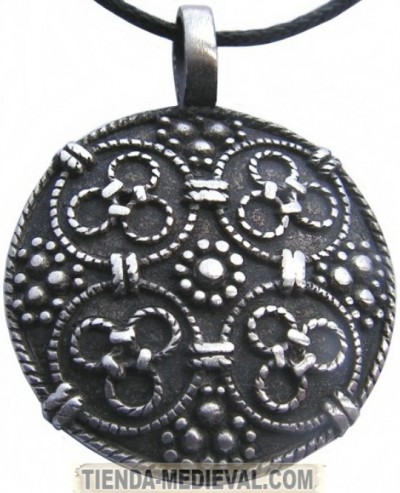
The Vikings were seafaring Scandinavian explorers who burst onto the historical scene around the 7th century and have been the subject of fabulous legends for many years. Their adventurous spirit and deep knowledge of navigation allowed them to explore and settle vast regions, from the British Isles to the Mediterranean and beyond.
Materials and Craftsmanship
Viking craftsmen were true masters at working a variety of materials to create their jewelry. Their skill and dedication were reflected in the quality and beauty of each piece, which was not only an ornament but also an expression of cultural and spiritual identity. The most common metals included:
- Silver: Very popular and abundant, often associated with moonlight and magical powers. It was the metal most used for most pendants and other jewelry, as it was relatively easy to obtain through trade and plunder.
- Gold: Rarer and reserved for the elite, symbolizing the sun, divine power and ultimate wealth. Gold pieces were an unmistakable sign of high social status and were mainly found in the burial goods of leaders.
- Bronze and Iron: Widely used for pieces more accessible to the general population, as well as for tools and weapons. Although less valuable than silver or gold, bronze and iron objects often featured intricate designs and were equally significant.
Besides metals, they used other precious or meaningful materials:
- Amber: Known as the “gold of the north,” it was highly prized for beads and pendants. Amber was believed to have protective and healing properties, and its warm glow made it very desirable.
- Glass and Semi-precious Stones: Used to create colorful beads and believed to confer special powers. These stones, often imported, added a touch of exoticism and value to the jewelry.
- Bone and Wood: Although less durable, they were also used to create simpler ornaments, especially in rural communities.
Viking goldsmithing stood out for its sophisticated techniques, which required great skill and knowledge of materials:
- Filigree: The art of working extremely fine metal wires to form complex designs, often spirals or interlaces, requiring great skill and patience. This technique allowed the creation of very delicate and detailed pieces.
- Casting (Molding): Allowed faster production of pieces, especially for amulets and simpler jewelry. Clay or stone molds were used to replicate designs, facilitating mass production of certain pendants.
- Repoussé: Consisted of hammering motifs onto metal plates, often seen on coins used as ornaments. This technique created relief on the metal surface, adding texture and depth to the design.
- Granulation: A technique that involved applying small metal spheres to the surface of the jewel and soldering them to create textured patterns. It was very labor-intensive and added a touch of luxury and sophistication.
- Inlay: The insertion of other materials, such as gemstones or enamel, into carved cavities in the metal, creating contrasts of color and texture.
The Language of Symbols: Emblematic Pendants and Their Meanings
Viking pendants carried deep spiritual and mythological meanings, serving as protective amulets or representations of their view of the cosmos and their gods. Each symbol was a window into the beliefs and values of Norse society, offering protection, guidance or connection to the divine.
Thor’s Hammer (Mjölnir)
The Mjölnir, or Thor’s hammer, the god of thunder’s weapon, is perhaps the most iconic and recognizable Viking symbol. It represented strength, protection against chaos, fertility and good fortune. It was used to bless marriages and sanctify the dead, and warriors wore it as an amulet to invoke divine protection in battle and ensure victory. The popularity of the Mjölnir spread throughout Scandinavia and beyond, becoming an omnipresent symbol of Viking faith and identity. There were variations in its design, from plain and functional to ornamented with engravings and filigree, and it was made in silver, bronze, gold or iron, depending on the wearer’s status. Viking pendants in the shape of Mjölnir were a constant reminder of Thor’s protective presence in daily life.
The Valknut
This enigmatic symbol, composed of three interlocked triangles, is closely associated with Odin, the supreme god of wisdom, war and death. It is believed to symbolize the transition between life and death, and it was an emblem of fallen warriors traveling to Valhalla, Odin’s great hall. It may also represent the interconnection of the nine worlds of Norse mythology or the cyclical nature of existence, fate and rebirth. It is a powerful symbol of strength, courage and fearlessness, often found on runestones and graves, suggesting its link to funerary rites and the afterlife.
Yggdrasil: The World Tree
Yggdrasil, the “World Tree” or “Tree of Life,” was the axis of Norse cosmology, a massive ash tree that connected the nine realms of existence, from Asgard (home of the gods) to Niflheim (the realm of mist and ice). It symbolizes the interconnection of all things, wisdom, knowledge and the cyclical nature of life and transformation. Representations of Yggdrasil in jewelry often showed intricate designs of intertwined branches and roots, sometimes accompanied by animal figures such as the dragon Níðhöggr gnawing its roots or the squirrel Ratatoskr running up its trunk. A Viking pendant featuring Yggdrasil was a reminder of the unity of creation and the pursuit of harmony.
The Runes
The runes were much more than a simple alphabet; these ancient Germanic characters were imbued with magical powers and used for communication, divination and protection. Runes carved on jewelry were believed to offer luck, protection or special abilities, such as the Algiz rune for defense and protection against evil, or Fehu for prosperity, wealth and success. The Vikings used them to invoke the help of the gods, to heal or to predict the future. Pendants with personalized runic inscriptions were highly valued, as they were believed to amplify the wearer’s intention. Viking art depicted everyday objects, such as tools, ships, utensils and jewelry, often adorned with these powerful inscriptions.
Other Relevant Symbols:
- Vegvisir (Viking Compass): A symbol of guidance and protection, ensuring one did not lose the way, especially at sea. Although it is a late Icelandic symbol (17th century), its message of direction and stability was much appreciated by a seafaring culture. It is said to help its wearer find the way amid storms and difficulties.
- Aegishjalmur (Helm of Awe): A powerful symbol of protection and power, believed to inspire fear in enemies and protect the wearer. It was often drawn on the forehead of warriors before battle to secure victory and invincibility.
- Odin’s Triple Horn (Triskelion): Three interlaced horns symbolizing wisdom, poetic inspiration and the quest for knowledge associated with Odin. It may also represent the three cups of poetic mead that Odin obtained.
- Huginn and Muninn (Odin’s Ravens): Odin’s ravens, “Thought” and “Memory,” represent insight and the ability to gather information. They were associated with death, transformation and the connection between the world of the living and that of the gods, as they flew the world bringing news to Odin.
- Gungnir (Odin’s Spear): Odin’s magical spear, which never missed its target, was a symbol of authority, power, courage and wisdom. A pendant depicting Gungnir represented determination and precision.
- Dragons and Serpents (Jörmungandr, Fafnir): They represented primal strength, chaos, protection or the cycle of life and death. The great Midgard Serpent, Jörmungandr, which encircled the world, was a common motif symbolizing the immensity and cyclical nature of the cosmos.
- Wolves (Geri and Freki, Fenrir): Odin’s wolves, Geri and Freki, symbolized loyalty and ferocity. Fenrir, the giant wolf, represented untamable strength and inevitable fate, often associated with Ragnarök.
- Crosses (Christianity): As Christianity spread through Scandinavia, crosses began to appear in Viking jewelry, often mixed with pagan motifs, reflecting the temporary coexistence of both beliefs.
Viking Jewelry as a Social and Cultural Mirror
Jewelry was a mirror of Viking society, revealing not only wealth but also status, gender and personal beliefs. Pieces made of gold and silver were reserved for the elite—jarls, high-ranking warriors and influential women—while those in bronze and iron were more common among the general population, though no less meaningful. Precious metal bracelets were not only ornaments but also a form of portable currency, which could be cut into pieces for trade, and their quantity indicated a person’s wealth and respect within the community. This practice underlines the economic and social importance of jewelry in the Viking Age.
There were gender differences in the use of jewelry: men typically wore bracelets, necklaces, rings and brooches to fasten cloaks, often with motifs of weapons or predatory animals. Women, meanwhile, wore elaborate brooches and fibulae, often in pairs, which were both decorative and functional to fasten clothing, especially “apron dress” style garments. Amber, glass or silver bead necklaces were also common. Thor’s hammer, for example, was mainly worn by men as a symbol of strength and protection in battle, while other amulets related to fertility or home protection were more common among women.
The importance of jewelry is evident in burial goods. The quantity and type of jewelry in a grave reflected the deceased’s status, wealth and role in society, providing valuable information about Viking beliefs and social structures. These objects not only accompanied the deceased on their journey to the afterlife but also served as a lasting testimony of their life and legacy.
Diversity and Connections: Regional and Commercial Influences
Extensive trade routes and Viking expeditions fostered a dynamic cultural exchange that was profoundly reflected in the design of their jewelry. The Vikings were not only warriors but also traders and explorers, which allowed them to come into contact with diverse cultures across Europe and beyond. Viking jewelry shows influences from the Anglo-Saxon world (especially in brooches and fibulae), the Frankish Empire (with its enameling and granulation techniques) and the Byzantine Empire (bringing more ornate designs and the use of gemstones). Particularly interesting are Eastern influences, where Arab silver coins (dirhams) were transformed into jewelry or melted to create new pieces, and Oriental motifs were incorporated into the Norse design repertoire, perfecting techniques like filigree and granulation, which already existed but reached a new level of sophistication.
Within Scandinavia, distinctive artistic styles developed and were applied to jewelry and other objects. Some of the most notable include:
- Borre style: Characterized by intricate animal motifs, often with interlaced bodies and triangular heads, creating a “mask” or “grip” effect.
- Jelling style: Features S-shaped animal figures with slimmer, more stylized bodies, often with knots and spirals.
- Mammen style: Complex animal motifs with spirals and foliage, often with a greater sense of volume and dynamism.
- Ringerike style: Characterized by acanthus leaf motifs, spirals and larger, more majestic animal figures.
- Urnes style: The latest, with highly stylized and elongated animal figures, interlaced in asymmetric and elegant patterns.
These styles not only influenced goldsmithing across the Norse region but also spread via trade routes and Viking settlements, leaving their mark on the art of other cultures they interacted with.
The Living Legacy: Viking Pendants Today
Today, Viking pendants continue to captivate our imagination and have experienced a notable resurgence in popularity. In the 20th century, there was growing interest in Norse history and mythology, driven by literary works, academic studies and, more recently, television series and films like “Vikings” or “The Last Kingdom.” This revived the popularity of ancient symbols such as Thor’s hammer and Odin’s ravens, which are now recognized globally.
Currently, Viking pendants are very popular fashion accessories, combining a deep historical sense with a modern touch. Contemporary designers reinterpret these millennia-old symbols using a variety of materials. Stainless steel is a common choice for its durability, corrosion resistance and modern finish, offering a contemporary and accessible style. Silver and gold, on the other hand, remain classic options that add a touch of elegance and authenticity, replicating the materials of the originals. Materials such as bronze, leather and wood are also used to recreate a more rustic, period-accurate aesthetic.
Beyond their aesthetic value, many wear them for their deep spiritual symbolism, seeking to connect with the energies and meanings of ancient Norse myths. A pendant featuring the Tree of Life (Yggdrasil), for example, can symbolize personal growth, connection with nature and the interconnection of all things. A Vegvisir can serve as a reminder of guidance and direction in life, while an Aegishjalmur can instill confidence and protection.
For those who own these pieces, proper maintenance is key to preserving their beauty and shine over time. For stainless steel, a gentle cleaning with water and soap is sufficient. For silver, regular polishing with a jewelry-specific cloth will help maintain its luster and prevent tarnishing. Viking pendants are a tangible testament to a complex and creative culture that left an indelible mark on history. By wearing them, we do more than adopt a fashion accessory; we honor an age-old legacy and connect with the rich narrative of the Norse peoples, carrying a piece of their adventurous and mystical spirit into our daily lives. If you have been captivated by the depth and beauty of these amulets, we invite you to explore our collection.

